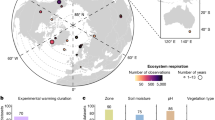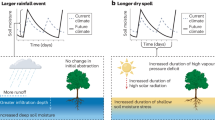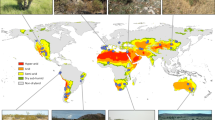Abstract
High latitudes contain nearly half of global soil carbon, prompting interest in understanding how the Arctic terrestrial carbon balance will respond to rising temperatures1,2. Low temperatures suppress the activity of soil biota, retarding decomposition and nitrogen release, which limits plant and microbial growth3. Warming initially accelerates decomposition4,5,6, increasing nitrogen availability, productivity and woody-plant dominance3,7. However, these responses may be transitory, because coupled abiotic–biotic feedback loops that alter soil-temperature dynamics and change the structure and activity of soil communities, can develop8,9. Here we report the results of a two-decade summer warming experiment in an Alaskan tundra ecosystem. Warming increased plant biomass and woody dominance, indirectly increased winter soil temperature, homogenized the soil trophic structure across horizons and suppressed surface-soil-decomposer activity, but did not change total soil carbon or nitrogen stocks, thereby increasing net ecosystem carbon storage. Notably, the strongest effects were in the mineral horizon, where warming increased decomposer activity and carbon stock: a ‘biotic awakening’ at depth.
This is a preview of subscription content, access via your institution
Access options
Subscribe to this journal
Receive 51 print issues and online access
$199.00 per year
only $3.90 per issue
Buy this article
- Purchase on Springer Link
- Instant access to full article PDF
Prices may be subject to local taxes which are calculated during checkout


Similar content being viewed by others
References
Tarnocai et al. Soil organic carbon pools in the northern circumpolar permafrost region. Glob. Biogeochem. Cycles 23, GB2023 (2009)
Schuur, E. A. G. et al. The effect of permafrost thaw on old carbon release and net carbon exchange from tundra. Nature 459, 556–559 (2009)
Sturm, M. et al. Winter biological processes could help convert arctic tundra to shrubland. Bioscience 55, 17–26 (2005)
Shaver, G. R. et al. Carbon turnover in Alaskan tundra soils: effects of organic matter quality, temperature, moisture and fertilizer. J. Ecol. 94, 740–753 (2006)
Hobbie, S. E. & Chapin, F. S. The response of tundra plant biomass, aboveground production, nitrogen, and CO2 flux to experimental warming. Ecology 79, 1526–1544 (1998)
Oberbauer, S. F. et al. Tundra CO2 fluxes in response to experimental warming across latitudinal and moisture gradients. Ecol. Monogr. 77, 221–238 (2007)
Natali, S. M., Schuur, E. A. G. & Rubin, R. L. Increased plant productivity in Alaskan tundra as a result of experimental warming of soil and permafrost. J. Ecol. 100, 488–498 (2012)
Hodkinson, I. D. et al. Global change and Arctic ecosystems: conclusions and predictions from experiments with terrestrial invertebrates on Spitsbergen. Arct. Alp. Res. 30, 306–313 (1998)
Deslippe, J. R., Hartmann, M., Simard, S. W. & Mohn, W. W. Long-term warming alters the composition of Arctic soil microbial communities. FEMS Microbiol. Ecol. 82, 303–315 (2012)
McKane, R. B. et al. Climatic effects on tundra carbon storage inferred from experimental data and a model. Ecology 78, 1170–1187 (1997)
Myers-Smith, I. H. et al. Shrub expansion in tundra ecosystems: dynamics, impacts and research priorities. Environ. Res. Lett. 6, 045509 (2011)
Rustad, L. E. et al. A meta-analysis of the response of soil respiration, net nitrogen mineralization, and aboveground plant growth to experimental ecosystem warming. Oecologia 126, 543–562 (2001)
Blok, D. et al. The response of Arctic vegetation to the summer climate: relation between shrub cover, NDVI, surface albedo and temperature. Environ. Res. Lett. 6, 035502 (2011)
Sullivan, P. F. et al. Climate and species affect fine root production with long-term fertilization in acidic tussock tundra near Toolik Lake, Alaska. Oecologia 153, 643–652 (2007)
Clemmensen, K. E., Michelsen, A., Jonasson, S. & Shaver, G. R. Increased ectomycorrhizal fungal abundance after long-term fertilization and warming of two arctic tundra ecosystems. New Phytol. 171, 391–404 (2006)
Wallenstein, M. D., McMahon, S. & Schimel, J. Bacterial and fungal community structure in Arctic tundra tussock and shrub soils. FEMS Microbiol. Ecol. 59, 428–435 (2007)
Oades, J. M. Soil organic matter and structural stability: mechanisms and implications for management. Plant Soil 76, 319–337 (1984)
Loya, W. M., Johnson, L. C. & Nadelhoffer, K. J. Seasonal dynamics of leaf- and root-derived C in arctic tundra mesocosms. Soil Biol. Biochem. 36, 655–666 (2004)
Lavoie, M., Mack, M. C. & Schuur, E. A. G. Effects of elevated nitrogen and temperature on carbon and nitrogen dynamics in Alaskan arctic and boreal soils. J. Geophys. Res. 116, G03013 (2011)
Six, J., Bossuyt, H., Degryze, S. & Denef, K. A history of research on the link between (micro)aggregates, soil biota, and soil organic matter dynamics. Soil Tillage Res. 79, 7–31 (2004)
Anisimov, O., a, Shiklomanov, N. I. & Nelson, F. E. Global warming and active-layer thickness: results from transient general circulation models. Glob. Planet. Change 15, 61–77 (1997)
Hobbie, S. E., Gough, L. & Shaver, G. R. Species compositional differences on different-aged glacial landscapes drive contrasting responses of tundra to nutrient addition. J. Ecol. 93, 770–782 (2005)
Deslippe, J. R., Hartmann, M., Mohn, W. W. & Simard, S. W. Long-term experimental manipulation of climate alters the ectomycorrhizal community of Betula nana in Arctic tundra. Glob. Change Biol. 17, 1625–1636 (2011)
Fahnestock, J. T., Jones, M. H. & Welker, J. M. Wintertime CO2 efflux from Arctic soils: implications for annual carbon budgets. Glob. Biogeochem. Cycles 13, 775–779 (1999)
Pollierer, M. M., Langel, R., Körner, C., Maraun, M. & Scheu, S. The underestimated importance of belowground carbon input for forest soil animal food webs. Ecol. Lett. 10, 729–736 (2007)
Loya, W. M. Pulse-labeling studies of carbon cycling in arctic tundra ecosystems: contribution of photosynthates to soil organic matter. Glob. Biogeochem. Cycles 16, 1101 (2002)
Oechel, W. C. et al. Recent change of Arctic tundra ecosystems from a net carbon dioxide sink to a source. Nature 361, 520–523 (1993)
Mack, M. C., Schuur, E. A. G., Bret-Harte, M. S., Shaver, G. R. & Chapin, F. S., III Ecosystem carbon storage in arctic tundra reduced by long-term nutrient fertilization. Nature 431, 440–443 (2004)
Fierer, N. & Schimel, J. P. Effects of drying–rewetting frequency on soil carbon and nitrogen transformations. Soil Biol. Biochem. 34, 777–787 (2002)
Bloem, J. Fluorescent staining of microbes for total direct counts. Mol. Microbial Ecol. Manual 1–12 (1995)
West, A. W. & Sparling, G. P. Modifications to the substrate-induced respiration method to permit measurement of microbial biomass in soils of differing water contents. J. Microbiol. Methods 5, 177–189 (1986)
Anderson, J. P. E. & Domsch, K. H. A physiological method for the quantitative measurement of microbial biomass in soils. Soil Biol. Biochem. 10, 215–221 (1978)
Beck, T. et al. An inter-laboratory comparison of ten different ways of measuring soil microbial biomass C. Soil Biol. Biochem. 29, 1023–1032 (1997)
Brookes, P. C., Landman, A., Prudenmaltese, G. & Jenkinson, D. S. Chloroform fumigation and the release of soil nitrogen: a rapid direct extraction method to measure microbial biomass nitrogen in soil. Soil Biol. Biochem. 17, 837–842 (1985)
Frey, S., Elliott, E. & Paustian, K. Bacterial and fungal abundance and biomass in conventional and no-tillage agroecosystems along two climatic gradients. Soil Biol. Biochem. 31, 573–585 (1999)
Ilic, B. et al. Single cell detection with micromechanical oscillators. J. Vac. Sci. Technol. B 19, 2825–2828 (2001)
Darbyshire, J. F., Wheatley, R. E., Greaves, M. P. & Inkson, R. H. E. A rapid micromethod for estimating bacterial and protozoan populations in soil. Rev. Ecol. Biol. Sol 11, 465–475 (1974)
Gough, L., Moore, J. C., Shaver, G. R., Simpson, R. T. & Johnson, D. R. Above- and belowground responses of arctic tundra ecosystems to altered soil nutrients and mammalian herbivory. Ecology 93, 1683–1694 (2012)
Acknowledgements
This research was supported by a DOE Global Change Education Program Graduate Fellowship, a Leal Anne Kerry Mertes scholarship, and Explorer’s Club grant to S.A.S., NSF OPP-1023524 to J.P.S., NSF OPP-0425606 and NSF OPP-0909441 to J.C.M., NSF OPP-0425827 and NSF OPP-0909507 to L.G., and the Arctic LTER program NSF-DEB 1026843 to G.R.S. We thank J. Laundre for temperature and thaw depth data. We also thank three anonymous reviewers, C. D’Antonio, J. King, and S. Viswanathan for comments that greatly improved this manuscript.
Author information
Authors and Affiliations
Contributions
S.A.S., J.C.M., L.G., J.P.S. and G.R.S. conceived the study and designed scientific objectives. J.C.M. and R.T.S. collected the soil food web data, L.G. and G.R.S. collected the plant data, S.A.S. and J.P.S. collected the soil chemistry data. S.A.S., J.C.M., L.G. and R.T.S. carried out statistical analyses. S.A.S. wrote the paper. J.P.S., J.C.M., L.G. and G.R.S. provided textual edits and all authors commented on the analysis and presentation of the data.
Corresponding author
Ethics declarations
Competing interests
The authors declare no competing financial interests.
Supplementary information
Supplementary Information
This file contains Supplementary Figures 1-2 and Supplementary Tables 1-4. (PDF 705 kb)
PowerPoint slides
Rights and permissions
About this article
Cite this article
Sistla, S., Moore, J., Simpson, R. et al. Long-term warming restructures Arctic tundra without changing net soil carbon storage. Nature 497, 615–618 (2013). https://doi.org/10.1038/nature12129
Received:
Accepted:
Published:
Issue Date:
DOI: https://doi.org/10.1038/nature12129
This article is cited by
-
Climate warming restructures food webs and carbon flow in high-latitude ecosystems
Nature Climate Change (2024)
-
Soil acidification drives the negative effects of nitrogen enrichment on soil microbial biomass at the global scale
Plant and Soil (2024)
-
Warming positively promoted community appearance restoration of the degraded alpine meadow although accompanied by topsoil drying
Oecologia (2024)
-
Investigating the long-term response of plateau vegetation productivity to extreme climate: insights from a case study in Qinghai Province, China
International Journal of Biometeorology (2024)
-
Temperature effect on erosion-induced disturbances to soil organic carbon cycling
Nature Climate Change (2023)
Comments
By submitting a comment you agree to abide by our Terms and Community Guidelines. If you find something abusive or that does not comply with our terms or guidelines please flag it as inappropriate.



